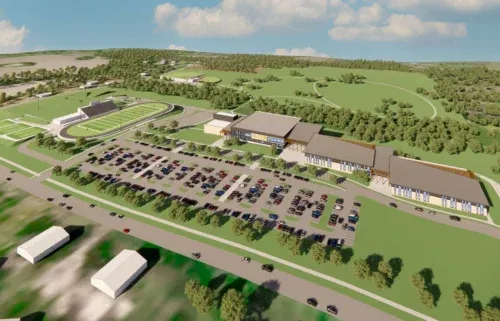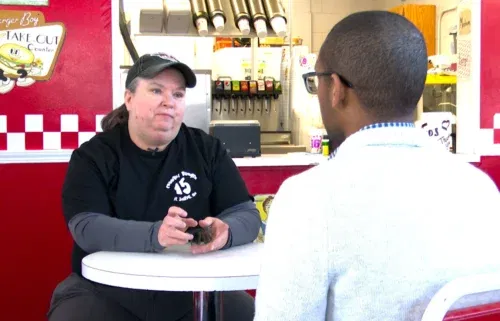Local health workers reflect on COVID-19 pandemic four years later

By Chris Fortune
In the nearly four years since COVID-19 was declared a pandemic, it brought forth an issue that health care workers are still dealing with today.
Concerns about the virus began building in late February 2020, and the World Health Organization declared COVID-19 a pandemic a few weeks later on March 11. Health care employees were identified as frontline workers, highlighting the stress and amplified workload they endured as they navigated from the unknown to fully realizing the threat they faced.
“It was tense, but exciting just because we weren’t — I don’t know if anybody for sure believed we would get to where we went,” said Aaron Dowis, director of five east surgical and step-down at Mosaic Life Care.
Nurse Practitioner Aryn Fidler remembers a staff meeting where employees were taught to prepare for COVID.
“They were teaching us how to gown up for COVID. And I thought, like, ‘Yeah, right, we’re never going to do any of this,’” she said while laughing. “And boy, did we do all of this.”
Once schools began to close and more residents started to arrive at the hospital seeking tests, hospital staff became nervous about bringing the patients in.
“We didn’t know what it would mean — who was going to take them, where you’re going to be taking those diseases home to your loved ones,” Dowis said. “I remember nurses who did not stay in the same house as their families. They sent their families away a month or two, like they saw their kids through a glass door.”
There was nonstop testing at Mosaic Life Care through March, and several weeks passed without a positive result. Dowis said he will never forget a phone call a friend made after learning he would be working with one of the first two patients who tested positive at the hospital.
“He literally comes in, he sees he’s got one of the positives, immediately calls his wife and says, ‘I’ve got one of the positives. Are we keeping the kids at home or not?’” he said. “It was that kind of a stress going on with the staff immediately that, you know, we were so much in the unknown.”
Mosaic Life Care staff were always provided with the safety equipment they needed, but there was an ever-present level of uncertainty as the situation continued to unfold. When caregivers first started training in preparation for the coronavirus, they wore large blue gowns.
“They were very thick, and they went the whole way around,” Dowis said. “Next thing you know, you don’t need that. You need just kind of a yellow gown that was kind of more papery.”
Sometimes the hospital would run short on supplies. Calls would be made for 10 face shields, but only three would be received. The hospital never ran out, but thoughts about whether it would raced through the minds of nurses at the time.
“You would see pictures on Facebook of nurses in like New York literally wearing trash bags, going into rooms,” Dowis said. “Were we going to get to that point? You didn’t know.”
As cases began to spread and nurses could begin to grasp the seriousness of the pandemic, Fidler said coming into the job was traumatizing. She was an ICU nurse during the pandemic.
“Being an ICU nurse, if your drips run out, you know, if you don’t have like a backup bag in the fridge, what if something horrible happens to your patients because you ran out of a bag of medication?” she said.
Nurses worked to do anything they could to help COVID patients. Fidler recalled a five-day stretch where she had a patient who died every single day.
“It was hard, it’s part of the job, it’s something that you’ve literally signed up for being a nurse,” she said. “You just never think that that’s really going to happen. But yeah, I’ll never forget that week. I still talk about it sometimes.”
Extra nurses arrived, and counseling services were expanded as the pandemic continued. Dowis would bring a counselor into his unit once a week so staff could see them onsite.
“It was just a lot to cope with,” he said. “I mean, just the day-to-day of coming in and knowing you’re going into a room where there is a disease that kills people and kills a lot of people. It was very stressful.”
Counseling was important for nurses who went through similar ordeals.
“Having those counseling services available to people through Mosaic really, really, really helped me,” Fidler said.
Nurses and others in the health care field were identified as frontline workers during the COVID-19 pandemic, and the St. Joseph community found opportunities to show appreciation for their efforts.
“There was one night where there was like a shift change was going on, the community came out and was like honking horns and doing lights and stuff as they came in,” he said. “I can’t tell you how many nurses cried that night.”
Workers at Mosaic Life Care rarely had to pay for their own lunch for the first few months of the pandemic.
“I think everybody had to go up a size on scrubs during the first several months of COVID,” he said. “Churches, restaurants, different community groups, doctors in the hospital (provided food), you name it. We ate like kings.”
But the support began to wane over time. Dowis said it faded when the Delta wave became the dominant variant around the summer of 2021.
“They were tired of restrictions, they were tired of masks, they were tired of being kept away from their loved ones,” he said.
Dowis said he understood the public’s weariness with COVID-19 restrictions because it was also tiring for nurses, but they started to become targets of that fatigue.
“You’re the one representing the rules, you’re the one that kind of was standing in the way of all of that stuff,” he said. “And so it shifted from so much support, a lot of times, to a really negative attitude a little bit.”
The aftermath of COVID also saw a rise in the disturbing trend of workplace violence.
“I don’t know exactly how, but somehow changes that happened in society during COVID — I don’t know if it’s attitude, culture or what has somehow made it OK that this workplace violence increase is going on,” he said. “Because I did not see workplace violence and attitudes from patients and families the way we see them now before COVID.”
Dowis said many families and visitors, starting with the Delta wave of the pandemic, did not respect safety rules or practices,
“Every day or two, I’m having to have a conversation with a family or a patient about appropriate care, and it’s not just verbal, it’s physical,” he said.
The attitude shift is still prevalent today. In a recent press conference, Mosaic announced staff had dealt with more than 300 workplace incidents over the past year.
“I have patients who will try to grab, push, pull, verbally accost,” Dowis said. “And where this became acceptable, I do not know, but it is common, and it did not used to be.”
But Dowis said health care is heading in the right direction because of all the lessons learned from experiencing COVID.
“The people who did go through it and the systems and everything are stronger from it, and we will continue to grow and be better from that,” he said. “And I very much appreciate the organization’s support. The people who went through it with me will always have a special place for me, and I’d do anything for them.”




